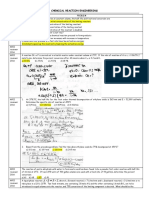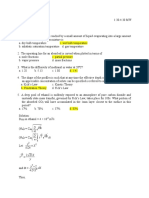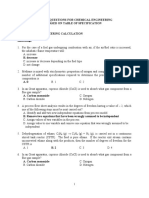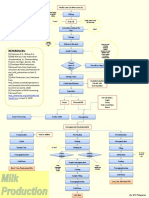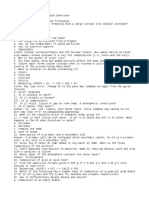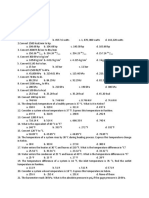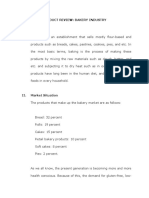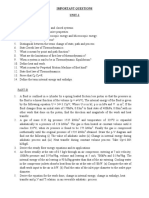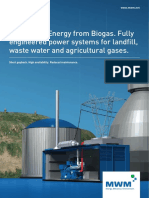Problem Set Mock Exam - CHE PDF
Problem Set Mock Exam - CHE PDF
Uploaded by
BenzeneCopyright:
Available Formats
Problem Set Mock Exam - CHE PDF
Problem Set Mock Exam - CHE PDF
Uploaded by
BenzeneOriginal Title
Copyright
Available Formats
Share this document
Did you find this document useful?
Is this content inappropriate?
Copyright:
Available Formats
Problem Set Mock Exam - CHE PDF
Problem Set Mock Exam - CHE PDF
Uploaded by
BenzeneCopyright:
Available Formats
CHEMICAL ENGINEERING PRINCIPLES
Ten grams of nitrogen gas at 17 degC are compressed adiabatically and
reversibly from an initial of 0.5 atm to 5 atm.
1. What is the final temperature of the gas at the end of the process?
a. 69.8 degC c. 287.0 degC
b. 164.8 degC d. 424.2 degC
2. What is the work associated with the process?
a. 2 kJ c. 5.6 kJ
b. 3.8 kJ d. 8 kJ
3. What is the final volume of the system?
a. 2.1 L c. 5.2 L
b. 3.3 L d. 9.5 L
100 moles of natural gas containing 80% methane, 15% ethane, and 5% propane
is burnt with excess air. 90% of the carbon in the feed is converted to CO2,
and the remaining 10% is converted to CO.
4. If 332.5 moles of oxygen was supplied during the combustion process, what
is the percent excess air used?
a. 25% c. 35%
b. 30% d. 40%
5. What is the percentage of oxygen in the ORSAT analysis of the flue gas?
a. 6.03% c. 7.62%
b. 6.85% d. 8.43%
6. How many moles of water vapor are formed in the product gas?
a. 158 moles c. 225 moles
b. 185 moles d. 252 moles
An electric power plant needs 120000 GPM of cooling water for its condensers.
In order to avoid thermal pollution, the cooling water will be cooled in a
cooling tower packed with wood grids. The cooling water will be cooled from
90 degF to 70 degF and reused in the condensers. The cooling tower will be
designed for inlet air with a dry bulb temperature of 90 degF and a wet bulb
temperature of 60 degF. The flow of water will be limited to a rate of 4
gallons per minute per ft2.
7. How much enthalpy is transferred from the cooling water to the air?
a. 8 x 10^8 BTU/hr c. 1.2 x 10^9 BTU/hr
b. 1 x 10^9 BTU/hr d. 1.5 x 10^9 BTU/hr
8. If the exit air is to be saturated at a temperature of 80 degF, what
should be the air flow rate in lb/hr?
a. 30 M lb/hr c. 70 M lb/hr
b. 50 M lb/hr d. 90 M lb/hr
9. Calculate the required tower cross-sectional area.
a. 15000 ft2 c. 25000 ft2
b. 20000 ft2 d. 30000 ft2
Mock Exam: Chemical Engineering Principles Page 1 of 11
ChE Review Center
MASS TRANSFER: HUMIDIFICATION
In a reactor where the volumetric flow rate is constant at 12 L/min, the
conversion of A is 85% according to the reaction A -> B. The entering molar
composition is 1.5 mol/L. For the reaction at 25 degC, use k = 0.258 min-1.
10. Calculate the reactor volume for a tubular reactor.
a. 41 L c. 75 L
b. 58 L d. 88 L
11. If the length of the tubular reactor was doubled, what would be the new
conversion?
a. 90.3% c. 97.8%
b. 94.2% d. 99.1%
12. Calculate the reactor volume for a backmix reactor.
a. 196 L c. 293 L
b. 264 L d. 350 L
Water flowing at 2.16 m3/hr at 320 K is pumped through a 40 mm I.D. pipe,
through a length of 150 m in a horizontal direction, and up through a
vertical height of 10 m. In the pipe there is a control valve, equivalent to
200 pipe diameters, and other pipe fittings equivalent to 60 pipe diameters.
Also in the line is a heat exchanger across which the head lost is 2 m water.
Assume that the main pipe has a roughness of 0.0002 m.
13. Calculate the velocity of the water in the pipe.
a. 0.20 m/s c. 0.40 m/s
b. 0.30 m/s d. 0.50 m/s
14. What is the total head to be developed by the pump?
a. 13.74 m c. 31.74 m
b. 17.43 m d. 37.14 m
15. What power must be supplied to the pump if it is 60 percent efficient?
a. 97 W c. 188 W
b. 135 W d. 206 W
A small cylindrical vessel costs $7,000 in 2002. Cost index for 2002 is
1104.2, cost index for 2007 is 1543.7.
16. It is desired to double the diameter and triple the height of the
vessel. What will be the new cost of the vessel?
a. $7,000 c. $31,100
b. $24,200 d. $84,000
17. What is the estimated cost of the larger vessel in 2007?
a. $9,800 c. $33,900
b. $22,200 d. $43,500
18. What is the estimated cost of the larger vessel in 2007, accounting for
annual inflation of 4%?
a. $11,900 c. $41,200
b. $27,000 d. $52,900
Mass Transfer: Humidification Page 2 of 1
ChE Review Center
CHEMICAL ENGINEERING PRINCIPLES
A furnace wall is constructed with 6-inch thick material whose average
thermal conductivity is 0.15 BTU/hr-ft-degF. The inside wall temperature is
1290 degF and the outside air temperature is 70 degF. The outside air
coefficient is determined to be 6.56 BTU/hr-ft2-degF.
19. What is the total heat transfer through 10 ft2 of wall area in BTU/hr?
a. 300 BTU/hr c. 3500 BTU/hr
b. 1600 BTU/hr d. 6400 BTU/hr
20. What is the total heat transfer through 10 ft2 of wall area in watts?
a. 88 W c. 642 W
b. 395 W d. 1026 W
21. If the inside wall temperature were increased to 2400 degF, how much
cork insulation (k = 0.025 BTU/hr-ft-degF) must be added to maintain the
same heat transfer rate?
a. 0.42 inches c. 0.95 inches
b. 0.81 inches d. 1.26 inches
Analysis of a limestone sample showed that it is composed of 92.89% calcium
carbonate, 5.41% magnesium carbonate, and 1.70% insoluble material. The
limestone is to be thermally decomposed through the process of calcination.
22. How many pounds of CaO can be obtained from 5 tons of limestone?
a. 4250 lb c. 5740 lb
b. 4940 lb d. 6180 lb
23. How many pounds of CO2 can be recovered per pound of limestone?
a. 0.30 lb c. 0.62 lb
b. 0.44 lb d. 0.76 lb
24. What is the percentage by weight of calcium oxide in the solid
calcination products?
a. 52.0% c. 93.9%
b. 92.4% d. 95.3%
A copper block (Cp = 0.398 kJ/kg-K) having a mass of 15 kg and a temperature
of 230 degC is placed in a well-insulated vessel containing 100 kg of water
initially at 30 degC.
25. What is the entropy change of the copper block?
a. -11.63 kJ/K c. 2.97 kJ/K
b. -2.97 kJ/K d. 11.63 kJ/K
26. What is the entropy change of the water?
a. -37.51 kJ/K c. 3.87 kJ/K
b. -3.87 kJ/K d. 37.51 kJ/K
27. What is the total entropy change?
a. 0.90 kJ/K c. 22.9 kJ/K
b. 7.47 kJ/K d. 31.5 kJ/K
Mock Exam: Chemical Engineering Principles Page 3 of 11
ChE Review Center
CHEMICAL ENGINEERING PRINCIPLES
A pilot-scale filter press having an area of 0.0414 m2 is used to filter
aqueous BaCO3 slurry at a constant pressure of 267 kPa. The filtration
equation obtained was t/V = 10.25 x 10^6V + 3.4 x 10^3, where t is in
seconds, V is in m3.
28. How long will it take to obtain 15 L of filtrate using the experimental
filter press?
a. 17 min c. 32 min
b. 25 min d. 40 min
29. If the same slurry and conditions are used in a leaf filter press with
A = 6.97 m2, how long will it take to obtain 1 m3 of filtrate?
a. 6 min c. 15 min
b. 9 min d. 51 min
30. How much filtrate will be obtained after running the leaf filter press
for a total of 30 minutes?
a. 1.6 m3 c. 3.5 m3
b. 2.2 m3 d. 4.8 m3
A fluid is pumped through a 4 inch Schedule 40 steel pipe to a tank vented to
the atmosphere at a rate of 330 gal/min. An orifice plate with a coefficient
equal to 0.60 is located within the length of the pipe. The head loss is
calculated to be 2.35 ft. The specific gravity of the fluid is 0.85 and its
viscosity is 0.9 cP.
31. What is the Reynolds number of the fluid?
a. 2.45 x 10^5 c. 7.88 x 10^5
b. 5.23 x 10^5 d. 1.21 x 10^6
32. What is the diameter of the orifice?
a. 1.88 inches c. 2.74 inches
b. 2.32 inches d. 3.47 inches
33. What is the pressure drop through the orifice?
a. 0.584 psi c. 0.866 psi
b. 0.720 psi d. 0.925 psi
Determine the molar volume (in cm3/mol) of n-butane at 510 K and 25 bar using
each of the following methods:
34. Ideal-gas equation.
a. 1438.7 c. 1762.5
b. 1696.1 d. 2091.4
35. Generalized compressibility-factor correlation.
a. 1239.2 c. 1480.1
b. 1391.6 d. 1592.8
36. Generalized Pitzer correlation for B^.
a. 1400.6 c. 1515.3
b. 1489.1 d. 1560.6
Mock Exam: Chemical Engineering Principles Page 4 of 10
ChE Review Center
CHEMICAL ENGINEERING PRINCIPLES
A liquid mixture containing 55% benzene and 45% toluene by weight is fed to a
fractionating column at a rate of 1000 kg/h. The concentration of benzene in
the distillate and the bottoms are 92% and 6% by weight, respectively.
37. If the reflux ratio is 2, determine the amount of vapor in the top
section of the column.
a. 1220 kg/hr c. 1700 kg/hr
b. 1470 kg/hr d. 2120 kg/hr
38. What percentage of toluene from the feed goes to the bottoms product?
a. 54% c. 83%
b. 68% d. 90%
39. If the relative volatility between benzene and toluene is assumed to be
constant at alpha = 3, what is the minimum number of stages required to
achieve the desired separation?
a. 3 c. 5
b. 4 d. 6
One kilogram of a saturated solution of sodium bicarbonate is cooled from 60
degC to 20 degC.
40. What is the final solubility in grams per 100 grams of H2O?
a. 9.6 c. 21.5
b. 11.1 d. 38.8
41. How many grams of sodium bicarbonate crystallizes out?
a. 36.3 c. 50.1
b. 42.7 d. 58.4
42. The saturated solution at 20 degC is then heated up until 166 grams of
water is evaporated. What is the final temperature of the solution?
a. 30 degC c. 40 degC
b. 35 degC d. 45 degC
A two-effect evaporator will be used to concentration 15000 kg/hr of raw milk
from 9.5% solids to 35% solids. Steam is available at 100 kPa gauge pressure,
and the pressure in the second effect is 20 kPa absolute. The overall heat-
transfer coefficients are 600 and 450 J/m2-s-degC for the first and second
effects, respectively. Assume the sensible heat effects can be ignored, and
that there is no boiling-point elevation.
43. What is the evaporating temperature in the first effect?
a. 74 degC c. 94 degC
b. 84 degC d. 104 degC
44. What is the steam requirement in the first effect?
a. 3500 kg/hr c. 7160 kg/hr
b. 5750 kg/hr d. 12200 kg/hr
45. What is the total surface area available for heat transfer?
a. 180 m2 c. 370 m2
b. 290 m2 d. 450 m2
Mock Exam: Chemical Engineering Principles Page 5 of 11
ChE Review Center
MASS TRANSFER: HUMIDIFICATION
A heat engine operating as a Carnot cycle between 1540 degF and 40 degF
rejects 250 BTU/lb of working fluid to the sink.
46. What is the work produced by the heat engine?
a. 190 BTU/lb c. 560 BTU/lb
b. 330 BTU/lb d. 750 BTU/lb
47. What is the Carnot efficiency?
a. 40% c. 82.7%
b. 75% d. 97.4%
48. What is the maximum entropy change for any process in the cycle?
a. 0.125 BTU/lbm-R c. 0.375 BTU/lbm-R
b. 0.25 BTU/lbm-R d. 0.5 BTU/lbm-R
One thousand kg/hr of wet solid containing 60% moisture is to be dried to 10%
moisture using 20000 kg/hr of air, which is fed to the drier at a temperature
of 34 degC with a relative humidity of 30%.
49. What is the initial humidity of the wet air?
a. 0.010 kg water/kg dry air c. 0.014 kg water/kg dry air
b. 0.012 kg water/kg dry air d. 0.016 kg water/kg dry air
50. What is the final humidity of the wet air?
a. 0.028 kg water/kg dry air c. 0.038 kg water/kg dry air
b. 0.032 kg water/kg dry air d. 0.045 kg water/kg dry air
51. How much moisture was removed from the solid material?
a. 376 kg c. 470 kg
b. 392 kg d. 556 kg
A 100 kg/hr solution containing 60 wt% of valuable material A and 40 wt%
water is treated with a pure solvent S in a countercurrent multistage liquid-
liquid extraction unit. The percent recovery of A must be 90%. A solvent to
feed ratio equal to 1.5 times the minimum is used. The distribution
equilibrium, is Y = 3X, where X = kg A/kg water in the raffinate and Y = kg
A/kg S in the extract. The solvent S used is totally immiscible with water.
52. What is the solvent flow rate used
a. 14 kg/hr c. 25 kg/hr
b. 18 kg/hr d. 28 kg/hr
53. What is the weight percent of the solute in the final extract phase?
a. 69% c. 80%
b. 75% d. 83%
54. How many ideal stages are needed to achieve the desired separation?
a. 3 c. 5
b. 4 d. 6
Mock Exam: Chemical Engineering Principles Page 6 of 11
ChE Review Center
CHEMICAL ENGINEERING PRINCIPLES
A fluid enters a 1-2 multi-pass shell and tube heat exchanger at 200 degC and
is cooled to 100 degC. Cooling water with a flow rate of 400 kg/hr enters the
exchanger at 20 degC and is heated to 95 degC. The overall heat transfer
coefficient Ui is 1000 W/m2-K.
55. Calculate the heat transfer rate
a. 30 kW c. 40 kW
b. 35 kW d. 45 kW
56. What is the mean temperature difference in the heat exchanger?
a. 76.3 degC c. 91.9 degC
b. 87.5 degC d. 92.5 degC
57. If the inside diameter of the tubes is 3”, how long is the heat
exchanger, assuming that the tubes span the entire length?
a. 0.58 m c. 1.74 m
b. 0.95 m d. 2.82 m
An insulated container of total volume 1.25 m3 is divided into two
compartments of different sizes. The first compartment has a volume of 1 m3
and contains pure nitrogen gas at 10000 Pa and 400 K. The second compartment
has a volume of 0.25 m3 and contains pure hydrogen gas at 20000 Pa and 300 K.
The entire system is initially at equilibrium and the gases may be taken to
be ideal.
58. If the insulating barrier is removed, allowing the two gases to mix
together, what will be the final temperature at the new equilibrium state?
a. 320 K c. 360 K
b. 340 K d. 380 K
59. What will be the new pressure of the system?
a. 12000 Pa c. 16000 Pa
b. 14000 Pa d. 18000 Pa
60. What is the partial pressure of nitrogen gas after the two gases mix?
a. 5600 Pa c. 8000 Pa
b. 7200 Pa d. 8400 Pa
A cooling water pump is operating at a speed of 2800 rpm. Its flow rate is
1000 gal/min at a head of 160 ft.
61. What is the specific speed of the pump?
a. 1000 c. 3000
b. 2000 d. 4000
62. What is the power requirement of the pump?
a. 10 kW c. 30 kW
b. 20 kW d. 40 kW
63. If the pump speed is increased to 5000 rpm, determine the new power
requirement.
a. 47 kW c. 133 kW
b. 80 kW d. 170 kW
Mock Exam: Chemical Engineering Principles Page 7 of 10
ChE Review Center
CHEMICAL ENGINEERING PRINCIPLES
64. When two centrifugal pumps are connected in series, the discharge
changes by a factor of ___.
a. 0.5 c. 2
b. 1 d. 4
65. Which among the following is not an assumption used in the development
of the Langmuir Isotherm?
a. The adsorbed molecules do not interact.
b. All the adsorption sites are the same.
c. Multilayer adsorption can occur.
d. None of the above.
66. Which among the following is used to absorb SO3 to produce oleum?
a. Ammonia c. Sulfuric acid
b. Sodium hydroxide d. Water
67. Which among the following is TRUE with regard to high pressure fluids
flowing inside shell and tube heat exchangers?
a. It should flow shell side for larger overall heat transfer
coefficient.
b. It should flow shell side to achieve smaller total pressure drop.
c. It should flow tube side if flow is co-current and shell side if
flow is countercurrent.
d. It should flow tube side to avoid the expense of high pressure shell
construction.
68. Which of the following uses air as a typical working fluid?
a. Otto cycle c. Diesel cycle
b. Rankine cycle d. Brayton cycle
69. The work done in a free expansion process is __________.
a. Negative c. Positive
b. Zero d. Maximum
70. What is the minimum temperature at which a vapor above a liquid will
continue to burn once ignited?
a. Explosive limit c. Flammability limit
b. Fire point d. Flash point
71. Which among the following increases the resistance to heat transfer in
conduction heat transfer?
a. Larger heat transfer area
b. Larger thermal conductivity
c. Larger thickness of material
d. Larger temperature difference
72. Skirt supports are most suitable for:
a. Thick-walled vertical vessels
b. Horizontal vessels
c. Thin spherical vessels
d. Tall vertical vessels
73. It is the animal fixative that comes from deers.
a. Musk c. Castor
b. Ambergis d. Zibata
Mock Exam: Chemical Engineering Principles Page 8 of 11
ChE Review Center
CHEMICAL ENGINEERING PRINCIPLES
74. Which of the following has the lowest moisture content at 25 degC and 1
atm?
a. Absolute humidity of 0.05 c. Wet bulb temperature of 53 degF
b. 60% relative humidity d. Dew point at 20 degC
75. Which among the following is most suitable for very high pressure gas
phase reactions?
a. Batch reactor c. Tubular flow reactor
b. Fluidized bed reactor d. Stirred tank reactor
76. Which among the following valves is used to prevent flow in the reverse
direction?
a. Diaphragm valve c. Isolation valve
b. Globe valve d. Check valve
77. The main rationale in using reheat in a Rankine cycle is:
a. To decrease the moisture content of the fluid coming out of the
turbine.
b. To increase the temperature of the liquid entering the boiler.
c. To increase the heat released in the condenser.
d. To decrease pump consumption.
78. In a packed column, channeling is prevented by which of the following
equipment?
a. Column sump c. Nozzles
b. Liquid distributors d. Raschig rings
79. Which of the following is not a step in a typical vapor-compression
cycle?
a. Isobaric evaporation c. Isochoric condensation
b. Isentropic compression d. Isenthalpic expansion
80. Which among the following is the raw material for the Ostwald process?
a. Nitrogen c. Hydrogen
b. Nitric oxide d. Ammonia
81. It is a membrane separation process where a component from a heated
liquid phase permeates through the membrane and is removed under low
pressure.
a. Reverse osmosis c. Pervaporation
b. Ion exchange d. Electrodialysis
82. In agitation, which among the following will not prevent swirling or
the formation of a vortex?
a. Installing baffles in the tank
b. Increasing the distance of the impeller from the base of the tank
c. Mounting the mixer in an angular off-center position
d. Offsetting the mixer horizontally on the x-axis
83. In plant design, what is a protective response which is initiated upon
detection of a process hazard?
a. Regulatory control c. Interlock
b. Sequence logic d. Failure logic
Mock Exam: Chemical Engineering Principles Page 9 of 11
ChE Review Center
CHEMICAL ENGINEERING PRINCIPLES
84. Which of the following is the Dow process?
a. Conversion of nickel oxide to pure nickel
b. Production of steel from molten pig iron
c. Refining of bauxite ore to produce aluminum oxide
d. Extraction of bromine from brine
85. Which among the following is not an exothermic process?
a. Methanol synthesis c. Oxidation of sulfur
b. Catalytic cracking d. Ammonia synthesis
86. For binary unicomponent diffusion, the concentration profile of the
diffusing component along the diffusion path is:
a. Linear c. Exponential
b. Quadratic d. Logarithmic
87. The half life of a second-order reaction is:
a. Always the same irrespective of the reaction
b. Dependent on the initial concentration of the reactants
c. Proportional to the final concentration of the reactants
d. Half the specific rate constant
88. Which among the following is preferred in the heap leaching of copper
and nickel from their respective ores?
a. Dilute cyanide solution c. Sulfuric acid
b. Nitric acid d. Hexane
89. This type of flow-measuring device is typically used for highly
corrosive fluids.
a. Rotameter c. Orifice meter
b. Coriolis flowmeter d. Magmeter
90. This phenomenon occurs in a fluid flow system when the local static
pressure drops below the vapor pressure of the liquid at the existing
temperature, resulting to damage to pumps and control valves from the
formation of “bubbles” or voids.
a. Cavitation c. Flashing
b. Choked flow d. Water hammering
91. For a zero-order reaction, the ratio of the volume of a backmix reactor
to the volume of a plugflow reactor, for the same reactant conversion and
conditions, is:
a. 0 c. 1
b. Between 0 to 1 d. Greater than 1
92. The primary consideration in the selection of a dryer is:
a. Bulk density of the product
b. Site of the proposed installation
c. Whether the drying process is batch or continuous
d. Physical properties of the material to be dried
93. This is the measure of a material’s ability to radiate absorbed energy.
a. Emissivity c. Absorptivity
b. Heat capacity d. Transmissivity
Mock Exam: Chemical Engineering Principles Page 10 of 11
ChE Review Center
CHEMICAL ENGINEERING PRINCIPLES
94. It is a liquid that does not flow at all until a threshold shear stress
is attained.
a. Bingham plastic c. Pseudoplastic
b. Dilatant fluid d. Rheopectic fluid
95. Sulphur addition in soap is done to
a. Improve the soap texture c. Increase its cleansing action
b. Fasten lather formation d. Cure pimples and acne
96. Fugacity and pressure are numerically equal when a gas is:
a. In standard state c. At high temperature
b. At high pressure d. An ideal gas
97. Which among the following is not an advantage of using a falling film
evaporator?
a. Large heating surface area
b. High resistance to scaling liquids
c. Good heat-transfer coefficients
d. Relatively low cost
98. Reaction conversion increases with an increase in temperature in the
case of which reaction?
a. Reversible endothermic c. Irreversible
b. Reversible exothermic d. Autocatalytic
99. The function of a transducer is to:
a. Modify the input signal
b. Convert the primary signal into a more useful quantity
c. Amplify the input signal
d. Codify or decodify the input signal
100. Which among the following metals is used as catalyst for the Haber-
Bosch process of producing ammonia from hydrogen and nitrogen gas?
a. Iron c. Nickel
b. Titanium d. Copper
Mock Exam: Chemical Engineering Principles Page 11 of 11
ChE Review Center
You might also like
- Preboard Exam Day1 SET ADocument12 pagesPreboard Exam Day1 SET AJeanne Cortez0% (1)
- ChE Day 1 Mock Board 2.0Document6 pagesChE Day 1 Mock Board 2.0zzrot167% (3)
- Api 2540Document8 pagesApi 2540biondimi100% (1)
- 25 0 ChE MOCK BOARD 4 4may2016 ANS KEY and SolnDocument6 pages25 0 ChE MOCK BOARD 4 4may2016 ANS KEY and SolnFran LeeNo ratings yet
- Day 2 1 PDFDocument17 pagesDay 2 1 PDFChristianNo ratings yet
- Kinetics Ans Key Master FileDocument10 pagesKinetics Ans Key Master FileJOANA RHEA SAGPAEYNo ratings yet
- D πt e D π t e dt X DX y y dXDocument16 pagesD πt e D π t e dt X DX y y dXArlene DeppNo ratings yet
- Sample Questions For Chemical EngineeringDocument36 pagesSample Questions For Chemical EngineeringChristopere DepasupilNo ratings yet
- November 2016 Board Exam Quastions PDFDocument11 pagesNovember 2016 Board Exam Quastions PDFBethel Grace TalhaNo ratings yet
- Flowchart of Milk Manufacturing ProcessDocument1 pageFlowchart of Milk Manufacturing ProcessBenzene100% (1)
- Codex Soy SauceDocument24 pagesCodex Soy SauceBenzene0% (1)
- CAPCIS Technical Note - H2S PartitioningDocument10 pagesCAPCIS Technical Note - H2S PartitioningBrenda Muñoz VergaraNo ratings yet
- Problem Set - Mock Exam - CHE PDFDocument11 pagesProblem Set - Mock Exam - CHE PDFleo besaNo ratings yet
- Saint Louis University: Chemical Engineering PrinciplesDocument6 pagesSaint Louis University: Chemical Engineering PrinciplesAileen MayaNo ratings yet
- Orca Share Media1541752718539 PDFDocument15 pagesOrca Share Media1541752718539 PDFJuneNeilBalacuitNo ratings yet
- D. Axial Flow Pump A. 0.62 C. Depressants: Mock Board Examination: Chemical Engineering PrinciplesDocument6 pagesD. Axial Flow Pump A. 0.62 C. Depressants: Mock Board Examination: Chemical Engineering PrinciplesEfraim AbuelNo ratings yet
- MCL 1st Mock Board Exam PDFDocument11 pagesMCL 1st Mock Board Exam PDFAdrian Joshua BernagaNo ratings yet
- Exam Final Preboard Chem EngDocument5 pagesExam Final Preboard Chem EngAira Jean Maningo100% (2)
- Physical and Chemical PrinciplesDocument7 pagesPhysical and Chemical PrinciplesJr DocorNo ratings yet
- Preboard Answer Key 1 PDFDocument11 pagesPreboard Answer Key 1 PDFAnonymous 0zrCNQ100% (1)
- Day 2 200 ItemsDocument25 pagesDay 2 200 ItemsRobert DelfinNo ratings yet
- Orca Share Media1541759628568 PDFDocument12 pagesOrca Share Media1541759628568 PDFJuneNeilBalacuit100% (1)
- REVIEWER FOR ChE COMPRE 07082018Document352 pagesREVIEWER FOR ChE COMPRE 07082018Ahe BeongNo ratings yet
- Refresher Day 1 Part 3Document3 pagesRefresher Day 1 Part 3Robert DelfinNo ratings yet
- Compiled 1 PDFDocument33 pagesCompiled 1 PDFJuneNeilBalacuitNo ratings yet
- CHE134P FINAL EXAM 2013 14 4tDocument10 pagesCHE134P FINAL EXAM 2013 14 4tAdrian Joshua BernagaNo ratings yet
- Day 3Document5 pagesDay 3Robert DelfinNo ratings yet
- Che Calculations 1 2014 - 20152 StudentsDocument2 pagesChe Calculations 1 2014 - 20152 StudentsAudreyWalangareDimalibotNo ratings yet
- ACFrOgA3Jfd8opBrwGcc8dXNGVRTX7o9eO3J0cU7F7rQa5CoEWTlyrcxSHxDSq5kYkX5w1IkpyWIhSy68d9Kz J6OGnrBiBQez7ycPdUzK0wUS2DjHXc4uSzpO1H zreWLcK7hE0uG - a25pXTAkH PDFDocument2 pagesACFrOgA3Jfd8opBrwGcc8dXNGVRTX7o9eO3J0cU7F7rQa5CoEWTlyrcxSHxDSq5kYkX5w1IkpyWIhSy68d9Kz J6OGnrBiBQez7ycPdUzK0wUS2DjHXc4uSzpO1H zreWLcK7hE0uG - a25pXTAkH PDFSarah SanchezNo ratings yet
- Heat and Mass Transfer Unit OperationsDocument5 pagesHeat and Mass Transfer Unit OperationsFran LeeNo ratings yet
- ARC Additional Problems MWFDocument5 pagesARC Additional Problems MWFonly. starNo ratings yet
- Physics ARCDocument3 pagesPhysics ARCRobert DelfinNo ratings yet
- Exam Final Preboard Gen EngDocument6 pagesExam Final Preboard Gen EngAira Jean ManingoNo ratings yet
- Thermodynamics Exam 2015 20161 For Students1Document1 pageThermodynamics Exam 2015 20161 For Students1Alvin Salmingo100% (1)
- Exam Final Preboard Phy ChemDocument5 pagesExam Final Preboard Phy ChemAira Jean ManingoNo ratings yet
- UquirilibiumDocument30 pagesUquirilibiumAlif Alfarisyi SyahNo ratings yet
- PhyChem NotesDocument146 pagesPhyChem NotesHina OdaNo ratings yet
- Chemical Engineering Board Exam Questions (Edited)Document11 pagesChemical Engineering Board Exam Questions (Edited)AkiNo ratings yet
- Chemical EngineeringDocument5 pagesChemical EngineeringErcille Mae Oraiz PacamoNo ratings yet
- ReviewerDocument22 pagesReviewerRobert DelfinNo ratings yet
- Day 1 - MockboardsDocument12 pagesDay 1 - MockboardsKhiara Claudine Espinosa100% (1)
- Process Control ProblemsDocument4 pagesProcess Control ProblemsMarco Sarmiento100% (1)
- Momentum Transfer Final NaDocument18 pagesMomentum Transfer Final NaAna Lorraine DalilisNo ratings yet
- ChE BE Nov 2017 PDFDocument5 pagesChE BE Nov 2017 PDFJulia Gimenez100% (1)
- November 2014 Board Exam QuestionsDocument5 pagesNovember 2014 Board Exam QuestionsKelly SisonNo ratings yet
- My FilesDocument18 pagesMy Filesjake dionisioNo ratings yet
- Gaseous FuelsDocument5 pagesGaseous FuelsEmmanuel Jimenez-Bacud, CSE-Professional,BA-MA Pol Sci100% (1)
- Day 1 Mock Board Exam: Name: DateDocument9 pagesDay 1 Mock Board Exam: Name: DateXZ Louise Pauleen Palmares100% (1)
- Biochemical EngineeringDocument37 pagesBiochemical EngineeringPepy PeachNo ratings yet
- GATE Chemical Engineering Solved Paper 2014Document24 pagesGATE Chemical Engineering Solved Paper 2014Robert DelfinNo ratings yet
- Review CheDocument4 pagesReview CheSheena Gagarin100% (1)
- Mock Board Day 2 Nov 2007 (NK)Document6 pagesMock Board Day 2 Nov 2007 (NK)paoloNo ratings yet
- Che Calculations 1 Set B July 10 2019Document2 pagesChe Calculations 1 Set B July 10 2019amielynNo ratings yet
- Organic Chemistry 2023 QuestionnaireDocument3 pagesOrganic Chemistry 2023 QuestionnaireJD6 Agarb100% (2)
- General Inorganic ChemistryDocument3 pagesGeneral Inorganic ChemistryJomarie Gañalongo100% (1)
- CHECALC Sample ProblemsDocument7 pagesCHECALC Sample ProblemshulyenNo ratings yet
- Comprehensive Exam 2022 Part 2Document6 pagesComprehensive Exam 2022 Part 2Annie LNo ratings yet
- Che Calculations 1 QuestionsDocument12 pagesChe Calculations 1 QuestionsDe Belen Jhoey67% (3)
- Mock Board Exam 3T PDFDocument4 pagesMock Board Exam 3T PDFChristianNo ratings yet
- Problem Set Mock Exam CHEDocument11 pagesProblem Set Mock Exam CHEFroileth PulidoNo ratings yet
- Pipe ExamDocument3 pagesPipe ExamVon A. DamirezNo ratings yet
- Day 2 Board ReviewDocument8 pagesDay 2 Board ReviewAkiNo ratings yet
- Exercise - Heat and Mass TransferDocument4 pagesExercise - Heat and Mass TransferNash JazearNo ratings yet
- Btu Min Btu Min Btu Min Btu Min 2 2 2 2 2Document8 pagesBtu Min Btu Min Btu Min Btu Min 2 2 2 2 2Elisif DeFair100% (1)
- Activity 1: Introduction To SetsDocument3 pagesActivity 1: Introduction To SetsBenzeneNo ratings yet
- Types of Food IngredientsDocument4 pagesTypes of Food IngredientsBenzeneNo ratings yet
- Flowchart of Milk Manufacturing ProcessDocument1 pageFlowchart of Milk Manufacturing ProcessBenzeneNo ratings yet
- Types and Uses of Additives in Dairy Products: B Gascoyne, Leatherhead Food Research, Leatherhead, UKDocument7 pagesTypes and Uses of Additives in Dairy Products: B Gascoyne, Leatherhead Food Research, Leatherhead, UKBenzeneNo ratings yet
- Food Chemistry 295 (2019) 198-205Document8 pagesFood Chemistry 295 (2019) 198-205BenzeneNo ratings yet
- Commercial Milk Products: Sweetened Condensed Milk Raw MaterialsDocument7 pagesCommercial Milk Products: Sweetened Condensed Milk Raw MaterialsBenzene100% (2)
- CHEESE - Raw MaterialsDocument8 pagesCHEESE - Raw MaterialsBenzeneNo ratings yet
- CpiDocument7 pagesCpiBenzeneNo ratings yet
- Cheese Manufacturing ProcessDocument8 pagesCheese Manufacturing ProcessBenzene100% (1)
- EconDocument18 pagesEconBenzeneNo ratings yet
- Product Review: Bakery Industry IDocument7 pagesProduct Review: Bakery Industry IBenzeneNo ratings yet
- DAY 2 (July 27, 2019)Document1 pageDAY 2 (July 27, 2019)BenzeneNo ratings yet
- MNDocument2 pagesMNBenzeneNo ratings yet
- DAY 0 (July 25, 2019) : Minute To MinuteDocument36 pagesDAY 0 (July 25, 2019) : Minute To MinuteBenzeneNo ratings yet
- Type Description Friction Speed Life Notes: StiffnessDocument27 pagesType Description Friction Speed Life Notes: StiffnessBenzeneNo ratings yet
- Staff HandbookDocument11 pagesStaff HandbookBenzeneNo ratings yet
- Sessions Contests GUIDELINES LongDocument6 pagesSessions Contests GUIDELINES LongBenzeneNo ratings yet
- Evap MriiDocument5 pagesEvap MriiBenzeneNo ratings yet
- Solar HydrogenDocument8 pagesSolar Hydrogenapi-3834013100% (2)
- Jan 2018 P1CDocument15 pagesJan 2018 P1CThant Hayman ThwayNo ratings yet
- Fluid 9ed Solution ManualDocument919 pagesFluid 9ed Solution ManualAmr f100% (1)
- Solution Manual For Fluid Mechanics Fundamentals and Applications 3rd Edition by Cengel Cimbala ISBN 0073380326 9780073380322Document36 pagesSolution Manual For Fluid Mechanics Fundamentals and Applications 3rd Edition by Cengel Cimbala ISBN 0073380326 9780073380322andreahobbskcpsmoengb100% (35)
- Fabric Brochure Letter Rev2 Web PDFDocument28 pagesFabric Brochure Letter Rev2 Web PDFMoamenNo ratings yet
- Important QuestionsDocument5 pagesImportant Questionstamilselvan nNo ratings yet
- 6.1 StudentDocument5 pages6.1 StudentNaman sharmaNo ratings yet
- Thermodynamics 2Document14 pagesThermodynamics 2Alexandros KouretsisNo ratings yet
- Agarwalgardner Decline Curves Analysis 2015Document16 pagesAgarwalgardner Decline Curves Analysis 2015semester5 upNo ratings yet
- Physics Quiz - 2Document4 pagesPhysics Quiz - 2Nestory mahunjaNo ratings yet
- Advances in Fluid Mechanics VI PDFDocument689 pagesAdvances in Fluid Mechanics VI PDFMario Ticona100% (1)
- EcartDocument18 pagesEcartMae Anne Ajero AnggoNo ratings yet
- MWM Segmentbroschuere Biogas enDocument16 pagesMWM Segmentbroschuere Biogas enthirupathi mookaiahNo ratings yet
- Revisionplan Iitentusiast LeaderDocument1 pageRevisionplan Iitentusiast LeaderRohitDalalNo ratings yet
- The Third Law of ThermodynamicsDocument10 pagesThe Third Law of ThermodynamicssamygoldNo ratings yet
- Idea - Master Thesis Projects IdeaDocument5 pagesIdea - Master Thesis Projects IdeaFoo BrandonNo ratings yet
- TGT Science 1Document6 pagesTGT Science 1devankgarg01No ratings yet
- Gas Turbine ControlDocument81 pagesGas Turbine ControlJonathan Anderson100% (1)
- Physics Chapter 4 Form 4 DEFINITIONDocument3 pagesPhysics Chapter 4 Form 4 DEFINITIONAnnie HonNo ratings yet
- Maximizing The Right Stuff-The Trade-Off Between Membrane Permeability and SelectivityDocument12 pagesMaximizing The Right Stuff-The Trade-Off Between Membrane Permeability and SelectivityBere RuizNo ratings yet
- Ks3 Chem 7g Eq 64marks Solids Liquids and Gases Only 14pgsDocument14 pagesKs3 Chem 7g Eq 64marks Solids Liquids and Gases Only 14pgsRumeysaNo ratings yet
- Dec 07Document55 pagesDec 07c_nghia100% (1)
- LR Energy Guidance Notes For The Calculation of Probabilistic Explosion LoadsDocument18 pagesLR Energy Guidance Notes For The Calculation of Probabilistic Explosion LoadsjmScriNo ratings yet
- Name - Class - : Year 7 C2 ParticlesDocument33 pagesName - Class - : Year 7 C2 Particleskrista100717No ratings yet
- FMGCEM40xx Series: Flue Gas AnalyserDocument6 pagesFMGCEM40xx Series: Flue Gas AnalyserMeindert gerssenNo ratings yet
- All India Test Series LeafletDocument8 pagesAll India Test Series LeafletResonance Kota100% (1)
- Dynamic Material BalanceDocument4 pagesDynamic Material BalanceSajid Amin ShahNo ratings yet
- Chemistry 1 - ExamDocument6 pagesChemistry 1 - Examnassorussi9No ratings yet





